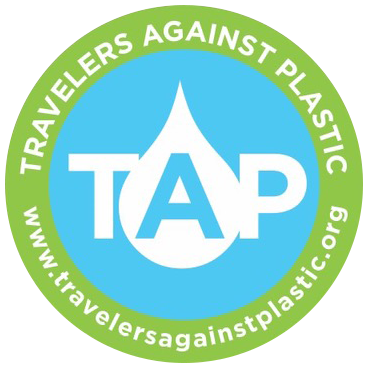By Brad Nahill – Director of SEE Turtles
NOVEMBER 6, 2018
If there is a poster species for the worldwide epidemic of plastic pollution, it’s sea turtles. The mothers swim through islands of plastic on their migrations and crawl through plastic to find their spots to nest on beaches. Nests are impacted by toxic microplastic particles and hatchlings crawl back through macroplastic on their way to the water. They confuse plastic bags and balloons for their favorite food, jellyfish. Straws get stuck in their noses and plastic spoons stuck in their throat. Even a few tiny pieces of plastic can end a small turtle’s life. They get caught in six pack rings and ghost fishing gear. It’s inescapable.
Travelers Against Plastic is leading the effort to eliminate plastic waste in the travel industry. A recent study by TAP and the Adventure Travel Trade Association (ATTA) showed that 60 percent of adventure travel operators, companies who specialize in visiting remote locations and whose livelihoods depend on a clean environment, still use single use plastic bottles on their tours. This translates to nearly 7 million bottles from this industry alone, most of which end up in landfills since many developing countries don’t offer recycling programs. TAP and ATTA are now teaming up to help adventure travel businesses educate their clients about this problem and offering solutions to reduce the need for disposable plastic while traveling.
As an organization working to protect endangered sea turtles, SEE Turtles is proud to be TAP’s first Gold Sponsor. We put an emphasis on reducing as much as possible the use of plastic on our trips. We provide clean filtered water for all travelers and encourage them to bring reusable plastic water bottles on our trips, as well as organizing beach cleanups on turtle nesting beaches around Latin America. We also recently partnered with The Grayl to bring several of their filters to a remote turtle nesting beach in Mexico to reduce their need for plastic bottles and encouraged tourism businesses at the AtMex Tourism Fair in Mexico to reduce their plastic use. Our new Divers For Turtles initiative will work with divers and the dive industry to reduce plastic use and encourage clean-ups. And we’re proud to be the first Gold Sponsor of Travelers Against Plastic.
There are many ways that travelers and tourism businesses can help sea turtles by reducing plastic use and cleaning up plastic when they see it:
Bring along a reusable water bottle when you travel and if you’re going to a place where tap water isn’t potable, consider bringing along a Steripen, Grayl, or other filter;
Bring along reusable bags whenever you might be offered a plastic bag, whether that’s the supermarket, farmer’s market, or department store;
Carry with you reusable cutlery, straws, and toiletry containers for shampoo and other liquids and ask for no straw when you go out to eat;
Participate in beach cleanup events (here is good link to find one near you) or bring along a bag whenever you visit the beach and clean up any plastic you find;
Bonus tip: tortoiseshell was plastic before plastic was invented and still threatens sea turtles in many places. Be sure to avoid buying these products when you travel and learn more at Too Rare To Wear.
Bio: Brad Nahill has worked in sea turtle conservation, ecotourism, and environmental education for 20 years. He is a former chair of the Awards Committee of the International Sea Turtle Society, co-author of the Worldwide Travel Guide to Sea Turtles, has authored several book chapters, blogs, and abstracts on turtle conservation and ecotourism, and has presented at major travel conferences and sea turtle symposia. Brad has a BS in Environmental Economics from Pennsylvania State University. He has been director of SEE Turtles since its founding and recently became President after the organization became an independent non-profit organization.
Images credit: Ben Hicks Fine Art and Neil Ever Osborne
